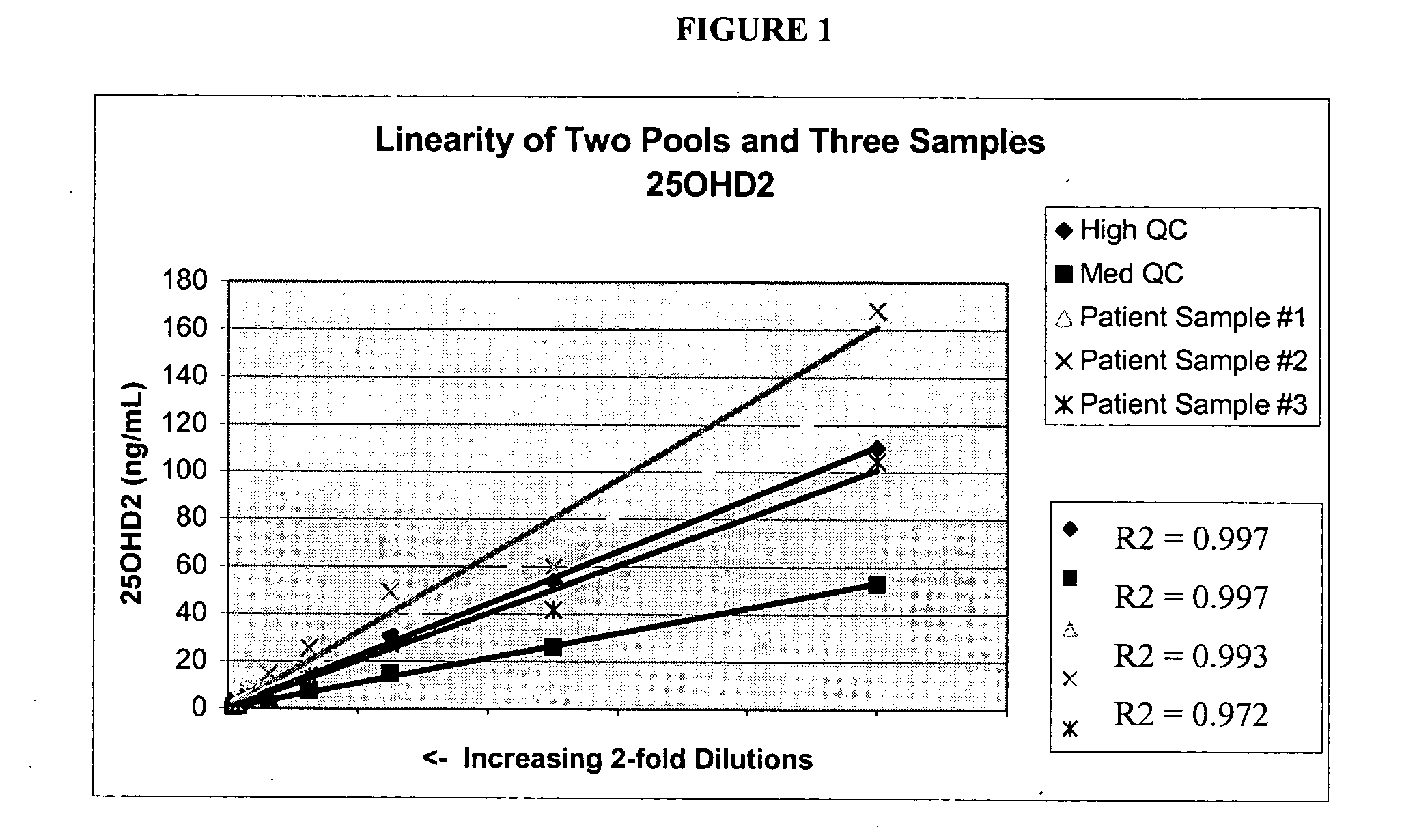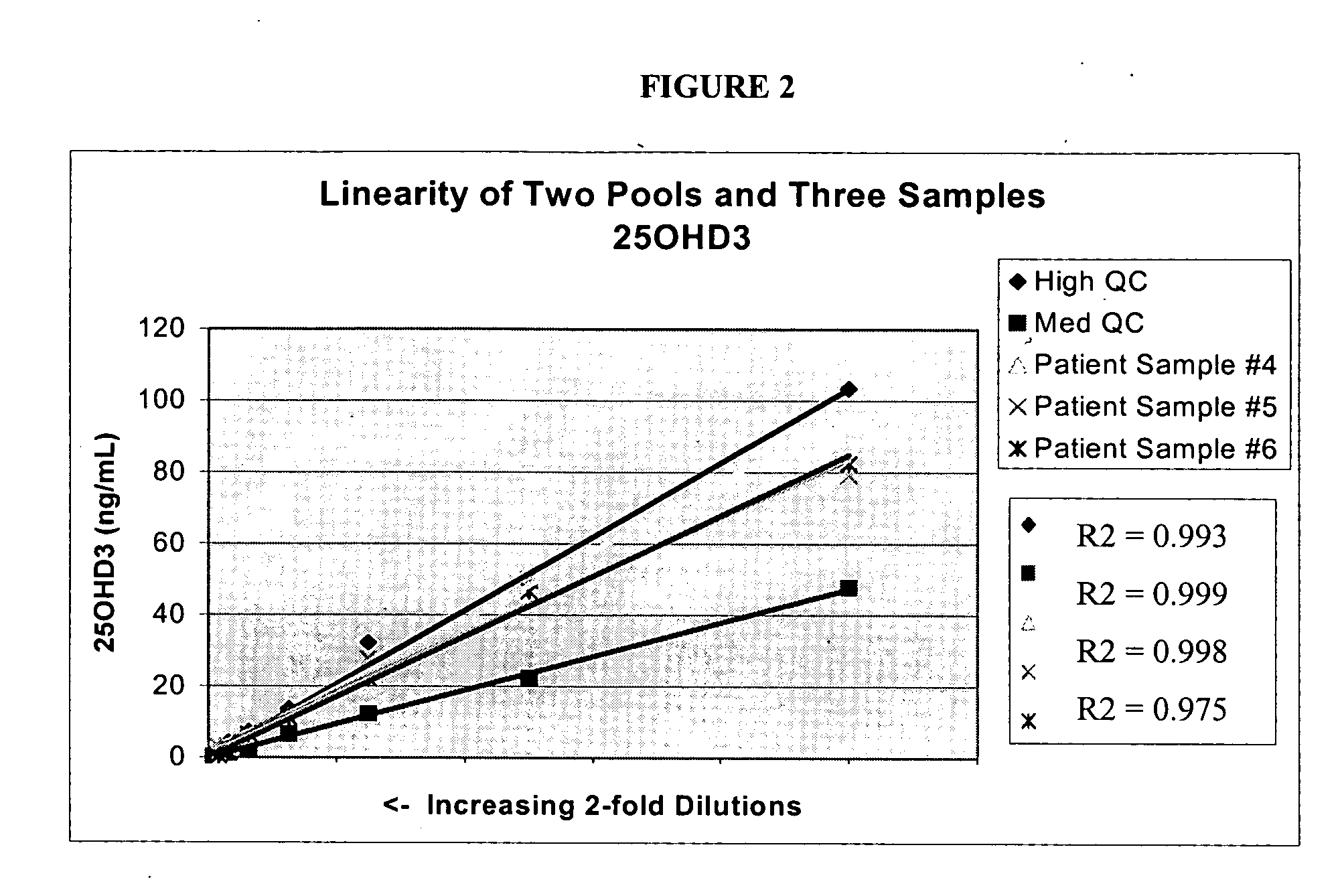Methods for detecting vitamin D metabolites
a technology of metabolites and detection methods, applied in the field of detection of vitamin d metabolites, can solve the problems of rare clinical setting measurement of vitamin d, inactive vitamin d precursors, limited diagnostic usefulness of tests, and limited diagnostic value, so as to achieve high turbulence and increase the degree of separation
- Summary
- Abstract
- Description
- Claims
- Application Information
AI Technical Summary
Benefits of technology
Problems solved by technology
Method used
Image
Examples
example 1
Determination of 25-hydroxyvitamin D3 and 25-hydroxyvitamin D2 by LC-MS / MS
[0047] Using a Perkin-Elmer MultiProbe II (S / N 432400) robotic liquid handler, human serum samples were first extracted using a protein precipitation method by adding 42.5 μl of serum of serum 170 μl of methanol (1:4 ratio of serum:methanol) in a 96-well plate format. For validation-related experiments, the methanol was spiked with hexadeuterated 25OHD3 (6D-25OHD3) as an internal standard. The 96 well plates were centrifuged which resulted in the precipitation of most protein in a pellet, while the vitamin D metabolites remained in solution in the supernatant. The supernatants were then transferred to an HPLC autosampler for loading to the LC-MS / MS analyzer.
[0048] LC-MS / MS was performed using a Thermo Finnigan LC-MS / MS analyzer (Thermo Finnigan Quantum TSQ (S / N: TQU00655)) with an atmospheric pressure chemical ionization (APCI) source used as the detector. Liquid chromatography was performed with a Cohesive ...
example 2
Intra-Assay and Inter-Assay Precision
[0053] Three levels of spiked serum were made from patient pools (Medium and High Pools) and stripped serum from Golden West Biologicals, Product #SP1070 (Low Pool). Each pool was spikes with stock solutions of 25OHD2 and / or 25OHD3 to bring analyte concentrations to the desired levels. The target concentrations of the control pools used for these determinations were: Low; 20-25 ng / mL, medium; 45-55 ng / mL and High; 100-110 ng / mL for each analyte. Twenty aliquots from each level were analyzed in a single assay using the LC-MS / MS protocols described in example 1. The following precision values were determined:
TABLE 2Intra-Assay Variation: 25-Hydroxyvitamin D2 (25OHD2)LowMediumHigh092804-L092804-M092804-H 126.546.4103.3 223.251.196.7 323.152.4107.8 421.650.3104.5 526.347.596.2 625.154.498.5 725.954.6100.0 821.950.1110.1 923.450.897.61023.553.2105.11122.252.9105.91224.054.694.51326.249.493.41424.159.0113.01525.852.9112.41623.959.2113.41729.552.4107...
example 3
Analytical Sensitivity: Limit of Detection and Limit of Quantitation Studies
[0057] To determine the limit of detection of the assay, blank diluent was analyzed 17 times within a single run using the LC-MS / MS protocols described in example 1. The mean and standard deviation was then calculated. The limit of detection was calculated as 2 SD above the mean of the blank peak area ratio based on a back calculation of peak area ratio against the calibration curve. The limits of detection were as follows: [0058] 25OHD2: 3.0 ng / mL [0059] 25OHD3: 3.5 ng / mL
[0060] To determine the limit of quantitation atandard curves of 25OHD2 and 25OHD3 were run in quadruplicate over five assays using the LC-MS / MS protocols described in example 1. The ranges were 0, 2, 4, 8, 16, 32, 64 and 128 ng / mL. The analyzed concentrations were pooled and the statistical analysis was performed on values from 5 separate runs. The results of the study were as follows:
TABLE 6Limit of Quantitation Study Results: 25-Hydr...
PUM
| Property | Measurement | Unit |
|---|---|---|
| concentrations | aaaaa | aaaaa |
| mass to charge ratio | aaaaa | aaaaa |
| mass to charge ratio | aaaaa | aaaaa |
Abstract
Description
Claims
Application Information
 Login to View More
Login to View More - R&D
- Intellectual Property
- Life Sciences
- Materials
- Tech Scout
- Unparalleled Data Quality
- Higher Quality Content
- 60% Fewer Hallucinations
Browse by: Latest US Patents, China's latest patents, Technical Efficacy Thesaurus, Application Domain, Technology Topic, Popular Technical Reports.
© 2025 PatSnap. All rights reserved.Legal|Privacy policy|Modern Slavery Act Transparency Statement|Sitemap|About US| Contact US: help@patsnap.com



